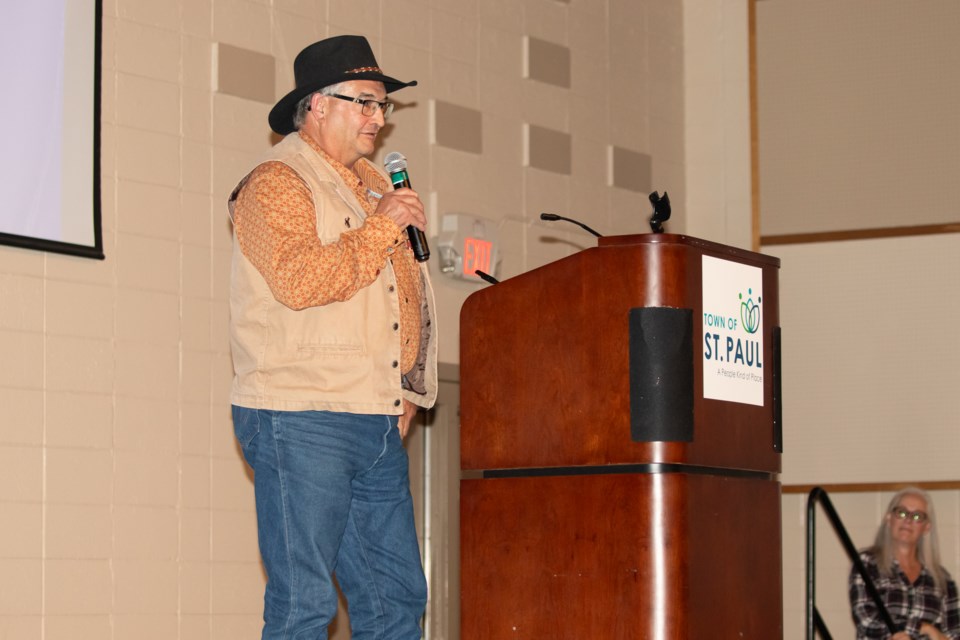ST. PAUL – After serving as president of the St. Paul Ag Society for more than a decade total, Andre Chamberland has officially stepped away from the position, with newly elected president Sean Dolan now taking the helm.
Chamberland served as president for a total of 12 years, starting from 2008 to 2014, then again from 2022 to 2024.
As he passes on the reins to Dolan, Chamberland recalls how the Ag Society has grown to what it is today – with many thanks going to the efforts of people who have now passed on – and those still living today.
The Ag Society, originally founded in 1914 by 106 individuals, actively promotes the agriculture community in the region, as well as hosting a variety of events in St. Paul.
In the 1960s, the Society became inactive for some time.
It wasn’t until 1972 when a group of six farmers decided to “bring the organization back to life,” explains Chamberland. These individuals were Jeann Chamberland, Richard Gottenbos, Alcide Hurtubise, Helmuth Neumann, Roger Plante, and Frank Schwengler.
“I call them the original six,” says Chamberland.
“They started a small rodeo in 1973,” held over the course of a few days. “We used to have a big beer fest, dance, and whatever else.”
Chamberland was 11 years old at the time. It was the same year he also joined the Society.
He says his family became deeply involved with the organization, so he joined at a young age. He thought it was fun - and he has been a part of the organization ever since.
“There's still some of the members in 1973 that are still alive, he says. “They are one of the reasons that we are here,” he adds, pointing out long-time members such as Diane Belland or Terry Holmgren.
The organization has only grown over the years.
Then, in 1988, the Ag Society brought the Lakeland Rodeo Association (LRA) Finals to St. Paul.
It’s an event that became tied to what is now known as St. Paul Rodeo Week, which annually draws people from across the province.
Chamberland says this growth of the rodeo in St. Paul is thanks to increased involvement and participation from the community. That dedication was also evident when the Ag Society decided to build the Ag Barn in 1991.
“The Ag Corral was built over time in multiple phases,” under various leaderships, Chamberland explains. It took over two decades of transformation until the Ag Barn became the Ag Corral in 2017.
This dedication is was what inspired Chamberland to step up as president in 2008, following Leo deMoissac’s retirement, who served as the Society’s president from 1999 to 2007.
“I would have gone through being an Ag Society member without being president, and would have been very happy to do it,” he says. “But when Leo [deMoissac] retired, he asked me to step up.”
Another inspiration to Chamberland was Dorine Kuzma, who served as the president from 1991 to 1996, and passed away in 2017.
“Dorine [Kuzma] was a long, long, long time member. Very much involved for probably 30 years for sure, if not more,” says Chamberland. “It took three people to replace her, because while she was the president, she’d also take care of the doors . . . advertising . . . sponsorship . . . and all that other stuff.”
“She did all that by herself,” says Chamberland.
But no matter how strong the organization had grown, nobody is immune to challenges. In 2020, the COVID-19 pandemic caused the closure of many community groups and non-profits across the nation – some permanently.
The pandemic was “a huge challenge for the Ag Society at the time,” he says. “It was hard.”
But following the pandemic, the Ag Society came back stronger.
“This past fall, when we had our 2024 Rodeo LRA Finals, we had sellout crowds and probably the biggest crowd we’ve ever had.”
This would not have been possible without that dedication from the community and the ag society, he says, especially when it comes to organizing such a massive event.
But Rodeo Week is only one event the society hosts each year. From high school rodeos, to agricultural events, fundraisers, and other initiatives and events, the ag society is involved in many things.
Being a witness to the growth, Chamberland is humble and says, “I was only a little part of the wheel that makes it go round and round."
“The organization only works when you have a group of people that come together and support each other . . . it’s not necessarily the leader, it’s that everybody pulls together to bring the organization together.”
And while Chamberland says it was time for him to step down from the leadership role, he has no intention to step away from the ago society entirely and plans to be involved for a long time.
He enjoys being part of the organization and there are new initiatives he wants to continue to be involved in, such as the Society’s newer bullarama and skijoring events.
“But I’ve put in 12 years . . . I’m at the age where I want to slow down a little bit,” and it’s time to have younger people come in and take the helm, he says.
“If you want the organization to keep growing, you have to pass it on to somebody that's younger and has some great ideas,” he acknowledges. “You’ve got to support them and their great ideas.”
Chamberland expresses confidence that the ag society will continue to flourish.
“It's a great organization, and it's very much rooted in our community.”



